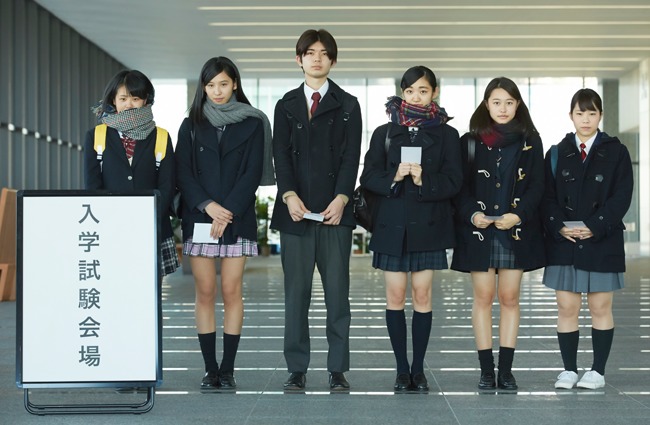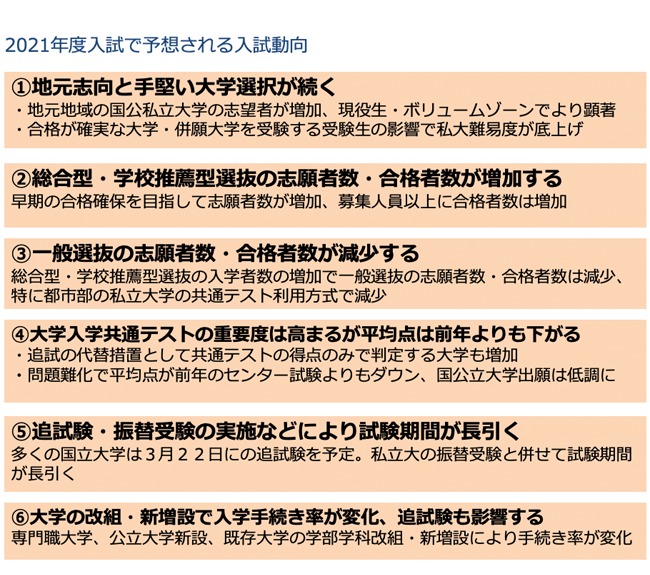
The total number of applications on the final day of application acceptance for the Common Test for University Admissions was announced, and the number of active students was about 44, which was almost the same as last year, but the number of high school graduates was about 7, which is close to 4000. It has decreased.Applications for the comprehensive selection (formerly AO entrance examination) have already begun, but with the number of applications for the Common Test for University Admissions known, the entrance examination has finally begun to move toward general selection.Here, I will focus on the six points where the overall trend is expected to see how university entrance exams in the first year of high school connection reform will work.
Local orientation and solid examinations lead to comprehensive / school-recommended selection
The 2021 university entrance exams will be subject to various changes in the entrance exam system at individual universities due to the impact of the reform of high school connection.Many national universities will conduct interviews and score new survey reports, and the entrance examination system will be significantly changed at Waseda University, Sophia University, Aoyama Gakuin University, Rikkyo University, etc. There are many changes that are directly related to the increase or decrease in the number of applicants, but here we have summarized the characteristics of the entrance examination trends for the 2021 entrance examinations that are expected at this stage by taking a bird's eye view of the overall trends of the entrance examinations.

① Local orientation and solid university selection continue
As an index showing the so-called local orientation of examinees, there is the enrollment rate in the prefecture of the school basic survey by the Ministry of Education, Culture, Sports, Science and Technology, and the enrollment rate in the prefecture has been gradual but consistently increasing since the 2000s. In 2019, it will be 43%, so if you consider not only your own prefecture but also students in Kanagawa prefecture, for example, going to a university in Tokyo, it will exceed 50%.This trend is expected to continue in the 2021 entrance exams.This tendency is especially strong among active students, and the tendency for mid-career students in the so-called volume zone to aspire to national, public and private universities in their local areas will continue.
In addition, as a characteristic of entrance examinations in recent years, there is a tendency to take the examination safely, such as firmly selecting a university that is sure to pass, and also firmly selecting a university that has a higher probability of passing.This tendency is becoming stronger as the difficulty level of entrance exams for mid-sized private universities has risen due to the impact of the increase in magnification and difficulty due to the decrease in the number of successful applicants at private universities.In addition, the last two years are more prominent in order to avoid taking the 2 entrance exam, which is the first year of high school connection reform.These entrance examination trends are affecting not only general selection but also general selection and school-recommended selection.
(XNUMX) The number of applicants and successful applicants for comprehensive / school-recommended selection will increase.
Examination behavior aiming for a solid pass is moving from general selection to comprehensive selection and school-recommended selection.This is because it is possible to avoid taking the common test for university admissions (hereinafter referred to as the common test), which is a new trend, and to secure a solid pass at an early stage.Even at national and public universities, the number of applicants for comprehensive / school-recommended selection is increasing year by year, and this may be due to the expansion of examination opportunities.In recent years, the number of applicants and successful applicants has increased at both national and public universities and private universities.In the case of national and public universities, there are many methods that require taking a common test, so it may be in February that the pass / fail will be determined, but at private universities, pass / fail will be decided by the end of the year. Even in the 2 entrance examination, the number of applicants for comprehensive / school-recommended selection is expected to increase more than last year.
Also, the accepting university will pass the exam if the number of examinees exceeds the pass line, even if the number of applicants greatly exceeds the number of applicants.Even if it becomes difficult to carry out general selection due to unforeseen circumstances, if the number of enrolled students is secured to some extent by the entrance examination within the year, the options for measures in case of emergency will expand.Depending on the university, it is expected that some departments will exceed the enrollment capacity with only enrollees recommended by the designated school.
- 1
- 2
